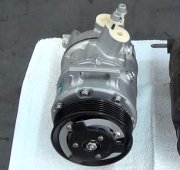Standard procedure is to bypass the low-pressure cut-off switch. Of course Ford does this differently than other manufacturers. The first thing I would try is simply adding from the first can. Set it upright in a pot of hot water to help the refrigerant go in. If enough pressure can be built up in the low side of the system, the compressor should start up on its own.
You can also bypass the "Wide Open Throttle" relay to turn the compressor on. The easiest way to do that is to remove it, pop its cover off, reinstall it that way, then squeeze the movable contact with your fingers to get it started. Once the compressor runs enough to draw in some refrigerant, the compressor cycling switch should keep it running.
Be aware refrigerant is extremely dangerous to work with. It can cause blindness and frostbite.
Professionals wear gloves, safety glasses, AND a face shield.
Also understand you're risking causing other problems when you charge from small cans. If there is any refrigerant in the system now, there is no way to know exactly how much is in there. If you add too much, liquid can spill over and get into the compressor and damage the valves and pistons. If there is no charge in the system now, there is likely air and moisture in it, and that will mix with refrigerant to form an acid that will corrode the metal evaporator and condenser. No professional would ever consider throwing the refrigerant in without first pumping the system into a near-perfect vacuum for a minimum of a half hour, and preferably a full hour. In a vacuum, water boils at 77 degrees and can easily be drawn out as a vapor. That vacuum also helps get the initial refrigerant charge into the system.
Besides corroded metal parts, moisture in the system will also freeze at the orifice valve and stop the flow of the refrigerant intermittently. That is one of the most common causes of the intermittent loss of cooling complaint.
Tuesday, May 2nd, 2017 AT 5:21 PM


